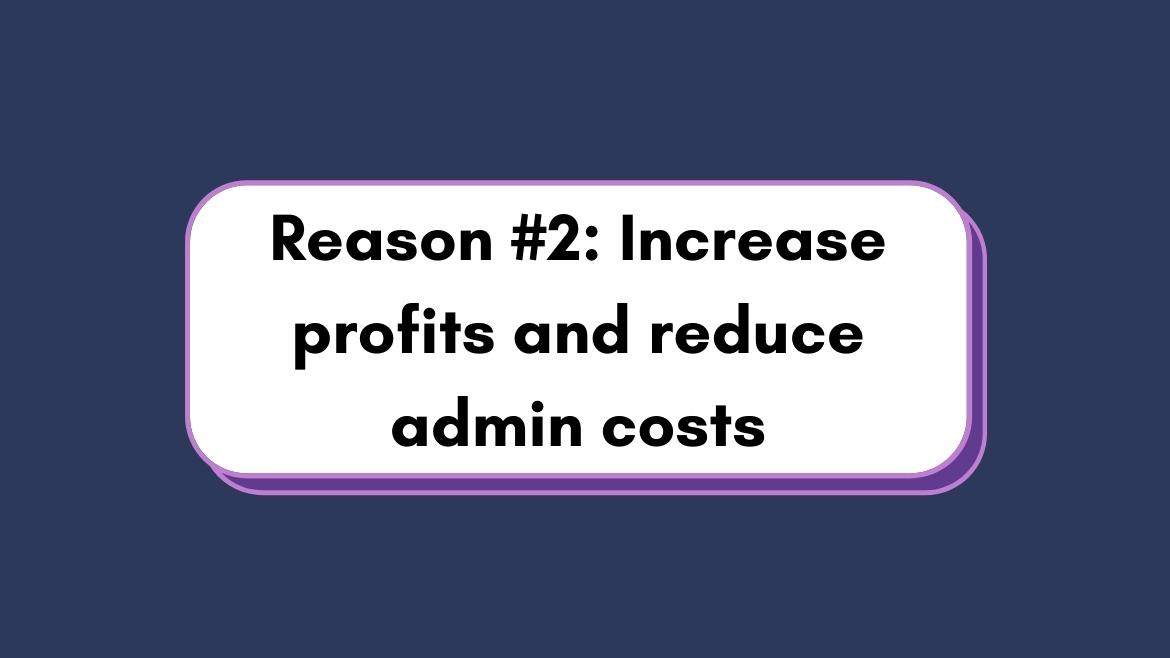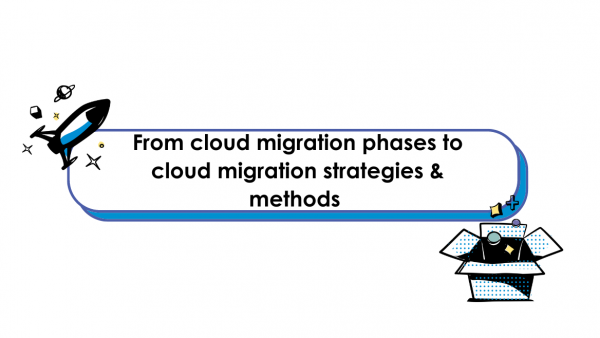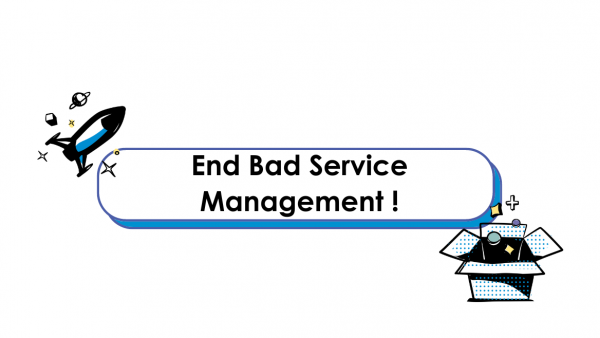Moving to the Cloud | Reason #2: Increase profits and reduce admin costs

Which is more expensive: hosting your tools on-premises (on-prem) or in the cloud? Ask a dozen people, and you’ll get a dozen different answers. While businesses tend to treat it as a simple question, it’s actually a rather complicated one.
If we’re talking about the monthly subscription cost of cloud vs. software licensing, cloud typically looks more expensive. If we factor in the additional costs of migration from on-prem, cloud will almost always be a more expensive short-term investment. But when we look at long-term value, that’s where on-prem starts to look less like the conservative choice and more like a consistent drain on your profits.
Why? Because, iceberg-like, the price tag of on-prem is mostly hidden, and bigger than you might think.
Systems downtime can cost three times as much as a year-long cloud subscription in a matter of minutes or hours. IT time and resources can be cut in half by a move off-prem. And that’s not even factoring in operational expenditures and the cost of overprovisioning resources (which impacts the majority of on-prem companies).
In fact, right-sizing your servers by moving to the cloud brings in an average annual cost savings around 30%, according to a recent study of 35,000 servers. And IT pros report an average of 20% overall cost savings after ditching on-prem, according to a study by Office 365.
So, the real question here isn’t what’s cheaper – it’s whether you’re taking the long or the short view. Are you comparing only the visible, up-front costs? Or looking at the big picture, factoring in the total cost of ownership – everything from IT time to server replacements? When you look past the tip of that iceberg, you’ll find a long list of ways that cloud saves money in the long run. Here are five of the ways cloud can cut off that hidden iceberg of cost:
Reduce – or even eliminate – the cost of major incidents
The average amount a company spends on downtime is $5,600 per minute, according to 2014 research by Gartner. And since 2014, that estimate has only gone up, with more recent reports putting the figure somewhere around $9,000.
Of course, that’s just an average – and some companies have a lot more to lose – like Facebook, whose 14-hour outage in 2019 lost them an estimated $90 million.
With on-prem, downtime falls squarely on the shoulders of your IT team, and it can you big in the form of line items ranging from revenue to internal productivity, SLA penalties, overtime, or on-call emergency pay.
This is one of the biggest opportunities for cost savings in the cloud. Instead of putting uptime on your team’s plate and hoping your servers and systems can handle a major incident, you outsource those responsibilities to your cloud vendor. Atlassian, for example, guarantees 99.95% uptime, and if an incident does happen, we’ve got the resources in place to resolve it, quickly and without additional cost to you.
Free up your IT team (because we all know time is money)
Make a list of all the things IT has to do to manage your on-prem servers and that list will get long fast. Performance upgrades. Scheduled upgrades. Security patches. Server replacements. VPN installations for remote access. Incident management. Change management. Manual integrations.
When you shift to the cloud, all those tasks fall squarely on the shoulders of your vendor. They’re responsible for upgrading security and maintaining servers, replacing old technology with new, and regularly upgrading software to address feature requests and bugs.
This means your IT teams – who tend to be situated on the high end of the pay scale, by the way – are free to focus on strategic or urgent tasks instead of tedious ones. It’s also why 74% of organizations say cloud gives their team a competitive advantage.
Reduce operational and physical costs
On-prem also comes with a lot of hidden operational and physical costs that simply aren’t a factor with cloud. This includes:
- Servers
With an average lifespan of 3-5 years, servers need to be regularly repaired and physically replaced. - Server support
Load balancers, climate control, server racks, replacement parts…in addition to the servers themselves, on-prem comes with some supporting hardware, parts, and physical assets that need to be purchased, maintained, and replaced at regular intervals. - Software renewal/licensing (and over-licensing)
Over-licensing costs US and UK companies as much as $34 billion per year. To avoid this common pitfall, companies either need to keep rigorous track of who needs which software, or they need to move to the cloud, where the number of users can often be automatically tracked, updated, and viewed by admins. - Electric bills
If 80% of servers are overprovisioned, that means 80% of on-prem companies are using more energy than they need and paying higher energy bills than they otherwise would. - Real estate/space
Physical servers call for physical space, which means a move to the cloud can open up existing space for other uses or remove data center real estate from your budget entirely. - Maintenance
Server maintenance often calls for temporary staff or contractors, which is a line item you can ditch when you delegate that responsibility to your cloud vendor. - Asset management time/audits
The more assets your IT team has (including physical servers, load balancers, and parts as well as non-physical assets such as software licenses and databases), the more your asset management practice has to track. This means more time, resources, and mental overhead.
Reduce environmental costs
Most of us would love to be more environmentally friendly for no other reason than it’s the right thing to do. But the additional good news is that when it comes to on-prem vs. cloud, the environmentally friendly option (cloud) is also the more affordable one.
The reason for this is, of course, that energy costs money. And using more of it than you need necessarily costs more. So when we say cloud is up to 98% more eco-friendly than on-prem, we’re also saying it’s cheaper.
Offload the cost of scaling
The vast majority of on-prem resources (80%) are overprovisioned, meaning companies are paying for far more computing power than they need. In those cases, a move to a cloud service that automatically scales resources up, down, in, and out saves these companies as much as 30% annually, according to research by TSO Logic.
The problem here is that, with on-prem hosting, your IT team makes an educated guess about how much computing power you’ll need. If they guess too high, you’re paying for resources – servers, load balancers, power – you don’t need.
On the other hand, if the team guesses too low, a lengthy, costly manual scaling process is in your future. You’ll need to add more servers or more computing power to meet demand – and that addition will require both money and manpower. Not to mention the weeks, if not months, of slow or unavailable services in the meantime, and the impact they could have on profits and customer loyalty. An incorrect guess in either direction, then, can have a major impact on your bottom line.
The solution here is to choose a cloud service with automatic scaling options. When usage spikes, your computing power grows to meet that demand. When usage slows, it scales down to save you money.
Calculating the cost of a cloud migration
The simplest way to calculate the return on any investment (including a move to the cloud) is this:
(Profit/gain from investment - investment) ÷ (investment) = ROI
So, for example, if you invest $50,000 in a migration from on-prem to cloud and you save or gain $50,000 per year after the migration, your equation would look like this over three years:
($150,000 - $50,000 = $100,000) ÷ ($50,000) = 2
In this example, your ROI over three years would be 2x (or 200%). In the first year, with that equation, you’d simply break even. In years two and three, though, you’d start to see real gains.
Now, sometimes it makes sense to do this calculation based on a year or two, but most cloud savings grow over time, since the up-front cost of a migration is a one-time expense and the savings on servers, software, IT, contractors, etc. are generally yearly savings. This means the ROI over time tends to chart up and to the right and understanding your true savings often means a calculation that spans multiple years.
In another example, if you invest $60,000 in a migration from on-prem to cloud and you save $45,000 per year in operating costs, your ROI in the first year will be negative (i.e. the one-time, upfront investment of migration cost more than you saved in year one). However, when expanded to a 3-year or 5-year model, the savings increase drastically.
In three years, you’ve more than broken even—and in year 5 you’ve almost tripled your investment.
Calculating investment and gains
The tricky part of this equation is calculating the two numbers you need for your ROI. To understand your initial investment in migrating from on-prem to cloud, you’ll need to add up the cost of professional services, internal resources, software licenses, data migration, cloud subscription, and any required re-training on cloud tools (if they differ from your on-prem tools).
Then, to calculate your gains, you’ll need to add up savings on hardware, software licenses, energy, real estate/server rooms/data centers, maintenance (including both employee time and external contractors), asset management time, incident management time, change management time, security upgrades, feature upgrades, and IT team or reduced headcount.
More difficult to calculate before you make the switch – but still important – are the cost of downtime (even a reduction of one hour per year can save companies hundreds of thousands), performance gains, and time saved by non-technical teams who have faster access to new features that increase productivity, collaboration, and security.
Don’t know where to start with migration planning?
Our team of experts can help you at every step of your migration - from assessment to getting up and running in the cloud. Let's talk.








